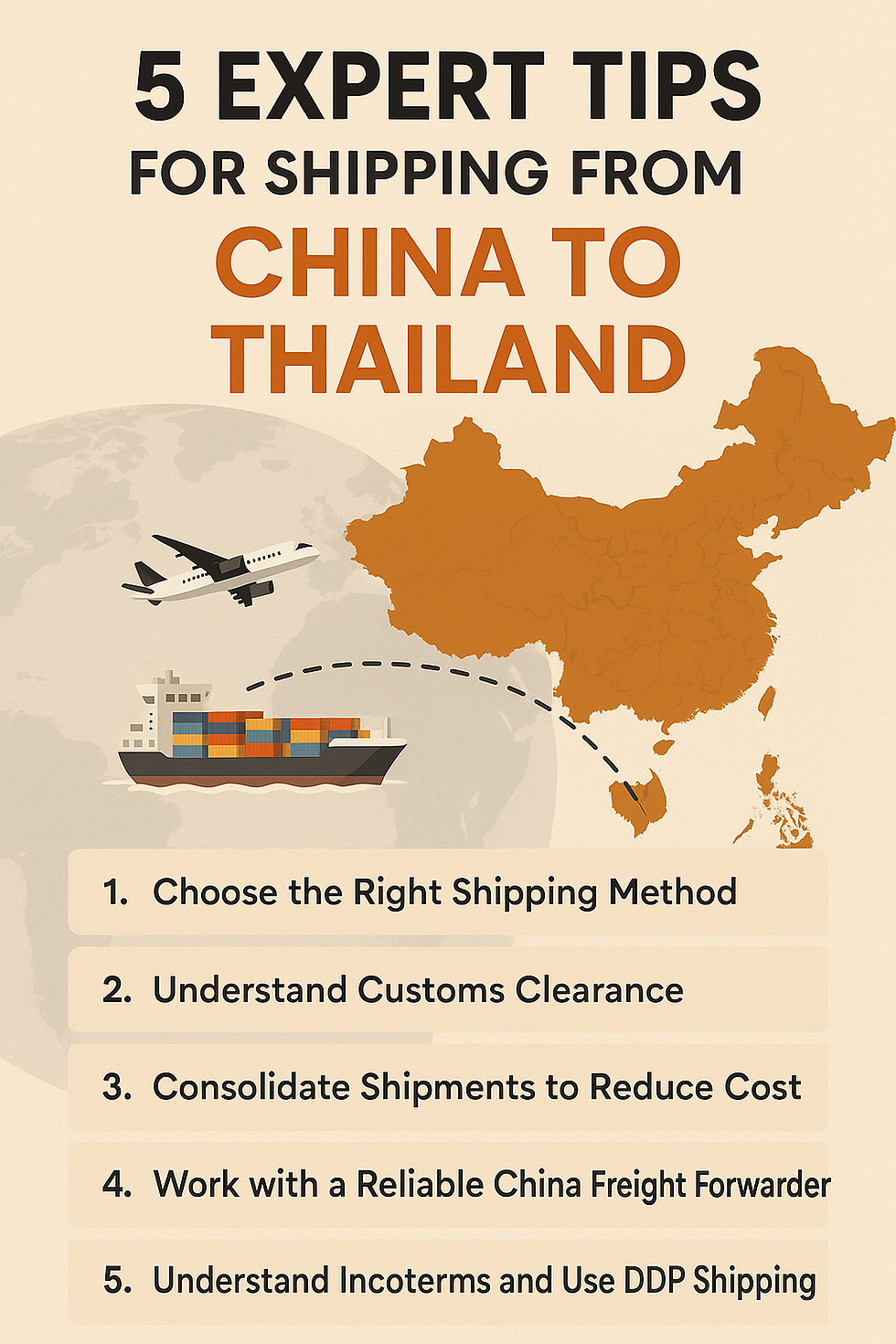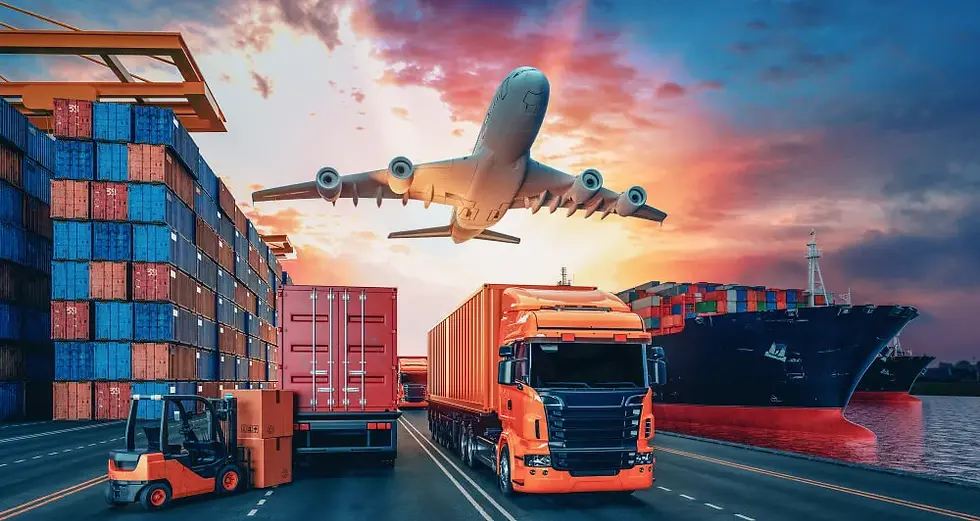5 Expert Tips for Shipping from China to Thailand: A Comprehensive Guide
- CNXtrans

- Jul 27
- 5 min read
Updated: Jul 29
Shipping goods from China to Thailand has never been more important for Thai importers, eCommerce entrepreneurs, and growing SMEs. With China being Thailand’s largest trading partner, businesses across Bangkok, Chiang Mai, Phuket, and beyond rely on efficient freight forwarding solutions to stay competitive.
Whether you're importing electronics, fashion, home decor, or industrial equipment, navigating the complexities of international shipping can be challenging. From choosing the right shipping method to avoiding delays at customs, success lies in preparation and partnering with a reliable freight forwarder.
In this comprehensive guide, we’ll reveal 5 expert tips for shipping from China to Thailand efficiently and affordably.
Tip 1: Choose the Right Shipping Method — Air Freight, Sea Freight, or Rail?
The most fundamental decision when shipping from China to Thailand is selecting the most suitable shipping method for your cargo. Your choice will directly affect cost, speed, and reliability.
1.1 Air Freight from China to Thailand
Best for: High-value, time-sensitive goods (electronics, luxury items)
Transit Time: 1–5 days
Cost: Higher per kg, but lower insurance risk
Ideal Airports: Guangzhou (CAN), Shenzhen (SZX), Shanghai (PVG), to Bangkok (BKK), Chiang Mai (CNX)
Pros:
Fast delivery
High security
Suitable for smaller shipments (under 300 kg)
Cons:
Expensive
Limited by weight/volume
Tip: Thai eCommerce sellers on platforms like Lazada and Shopee often prefer air freight from China to Thailand for speed and reliability.
1.2 Sea Freight (FCL and LCL)
Best for: Large, heavy shipments (furniture, building materials, bulk goods)
Transit Time: 7–14 days (port to port)
Cost: Much lower per kg than air freight
Key Ports:
China: Shanghai, Ningbo, Guangzhou, Shenzhen
Thailand: Laem Chabang (BKK), Bangkok Port (Klong Toey)
FCL (Full Container Load): Ideal if you’re shipping enough to fill a 20ft or 40ft container
LCL (Less-than-Container Load): Share container space with others to save cost
Tip: Use a freight forwarder like CNXtrans that specializes in LCL consolidation from China to Thailand to reduce shipping cost for small to mid-size businesses.
1.3 Rail Freight (China-Laos-Thailand)
With the new China-Laos-Thailand railway connection, rail freight is gaining popularity.
Transit Time: 5–10 days
Cost: Lower than air, faster than sea
Route: Kunming (China) → Vientiane (Laos) → Nong Khai/Bangkok (Thailand)
Rail is ideal for goods from Yunnan or southern China, especially for manufacturers in Kunming or Guangzhou.
Tip 2: Understand Customs Clearance in Thailand
Thailand’s customs procedures can make or break your shipping timeline. Understanding how Thai customs work—and preparing documents correctly—is essential.
2.1 Key Customs Documents
Commercial Invoice
Packing List
Bill of Lading (B/L) or Air Waybill (AWB)
Import License (for restricted goods)
Certificate of Origin (Form E) — to benefit from ASEAN-China FTA tariff reductions
2.2 Import Duties and Taxes in Thailand
Thailand imposes:
Import Duty: Varies by product HS code (0%–60%)
VAT: 7% on CIF (Cost + Insurance + Freight)
2.3 Tips to Avoid Delays
Use accurate product HS codes
Ensure invoice values match market value
Avoid undervaluation — Thai customs can seize or fine
Partner with a local customs broker or a reliable freight forwarder like CNXtrans who handles Thailand-side clearance
Tip 3: Consolidate Shipments to Reduce Cost
If you're shipping small quantities or buying from multiple Chinese suppliers, consolidating your goods into one shipment can massively reduce costs.
3.1 What is Cargo Consolidation?
Consolidation involves combining multiple small shipments into a single container (LCL) or air freight consignment. This is done at the origin warehouse (e.g., in Shenzhen or Yiwu).
3.2 Benefits of Consolidation
Lower shipping cost per item
Reduced import duties and clearance fees
Simplified tracking and documentation
Example: You're buying 100 kg of accessories from 5 different factories in Guangzhou. A freight forwarder like CNXtrans can combine these into one LCL shipment to Thailand—saving you time and money.
3.3 Door-to-Door Delivery with Consolidation
Many forwarders now offer door-to-door delivery from China to Thailand, combining:
Pickup from multiple suppliers
Warehousing
Consolidated shipping
Customs clearance
Final delivery to your Thai address
Tip 4: Work with a Reliable China Freight Forwarder
Finding the right freight forwarding partner in China is perhaps the most critical step in your logistics journey. A good freight forwarder handles everything from documentation and customs to real-time tracking and problem-solving.
4.1 Why Choose a China-Based Freight Forwarder?
Local knowledge of Chinese ports and suppliers
Fluent in Chinese and English/Thai
Access to better rates with Chinese carriers
Can consolidate shipments from multiple suppliers easily
4.2 What to Look For
Experience with China–Thailand shipping
Offers multiple transport options (air, sea, rail, DDP)
Provides door-to-door service
Transparent pricing with no hidden fees
Responsive support (WeChat, WhatsApp, Email)
✅ Recommended Forwarder: CNXtrans Based in China and known for its professional handling of shipments to Thailand, CNXtrans offers:
LCL consolidation
DDP air & sea shipping
Thailand customs clearance
Pickup from multiple Chinese suppliers
End-to-end tracking
Their services are ideal for importers who want hassle-free shipping without dealing with multiple agents or brokers.
Tip 5: Understand Incoterms and Use DDP Shipping When Possible
Incoterms define the roles and responsibilities between buyer and seller in international trade. Choosing the wrong one can lead to unexpected costs.
5.1 Common Incoterms for China–Thailand Trade
EXW (Ex Works): You, the buyer, handle all shipping from the factory onward
FOB (Free On Board): Seller delivers to port; you arrange shipping
CIF (Cost, Insurance, Freight): Seller ships to Thai port; you handle customs
DDP (Delivered Duty Paid): Seller or forwarder handles everything, including import taxes and delivery to your address
DDP shipping from China to Thailand is growing in popularity for SMEs and first-time importers. It removes all customs and delivery headaches.
5.2 Advantages of DDP Shipping
No need to deal with Thai customs yourself
All costs (freight, duty, VAT, clearance, delivery) included in one quote
Less risk of delays, fines, or hidden fees
Final Thoughts: Mastering China–Thailand Shipping in 2025 and Beyond
Shipping from China to Thailand is no longer just about moving boxes—it’s about strategy, partnerships, and optimization. Whether you're a large manufacturer, an Amazon FBA seller, or a startup sourcing products from Alibaba, following these 5 expert tips will help you save money, avoid delays, and grow your business sustainably.
Recap of Key Takeaways:
Choose the right shipping method for your product type, timeline, and budget.
Understand Thai customs and prepare your documents properly.
Consolidate shipments from multiple Chinese suppliers to reduce costs.
Work with a reliable China-based freight forwarder like CNXtrans.
Use DDP shipping to simplify logistics and minimize surprises.
Suggested Services: CNXtrans — Your Trusted Shipping Partner from China to Thailand
Whether you're shipping to Bangkok, Phuket, Chiang Mai, or anywhere in Thailand, CNXtrans offers:
Air, sea, and rail freight options
LCL consolidation
DDP shipping
Door-to-door delivery
Thai customs clearance
Multilingual support
FAQ: Shipping from China to Thailand
Q1: What’s the cheapest way to ship from China to Thailand?
A: Sea freight (especially LCL) is usually the most economical for large or heavy shipments.
Q2: How long does shipping from China to Thailand take?
A: Air freight takes 1–5 days, sea freight 7–14 days, and rail freight 5–10 days depending on the route.
Q3: What’s DDP shipping from China to Thailand?
A: Delivered Duty Paid (DDP) shipping includes all costs—shipping, customs clearance, taxes, and final delivery—handled by the forwarder.
Q4: Can I consolidate goods from multiple Chinese suppliers?
A: Yes! Use a service like CNXtrans to consolidate your shipments into one cost-effective delivery.
Need a China-based Shipping Agent to help you consolidate and ship internationally from China?





Comments